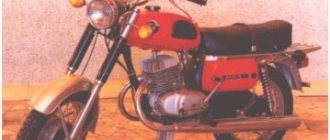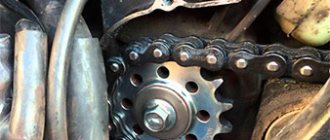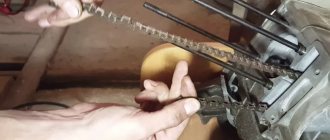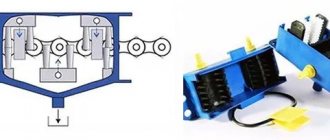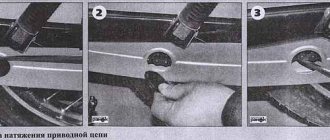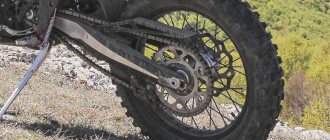Unlike a car, a motorcycle requires regular maintenance of many components, including the transmission, which uses a traditional chain drive. Without regular lubrication, it quickly wears out and gradually destroys other components - the rear wheel sprocket, gearbox and others. To ensure maximum longevity from your motorcycle, you should know how to properly lubricate and clean your chain. Following the recommendations given in the article will allow you to get rid of many problems and enjoy driving without thinking about expensive repairs.
How and with what to clean a motorcycle chain?
The vast majority of two-wheelers use chains, which play an important role in transferring power to the rear wheel. Failure of this unnoticeable part will prevent further driving, so you must ensure that the chain is clean and lubricated at the same time. That's why, from the outset, we warn against the rookie mistake of going to a touchless car wash or using a pressure washer. A strong stream of water combined with detergent is actually great at removing dirt. But at the same time, it washes away the lubricant that is on the chain links, and this should be avoided.
006_MOTO_0310_061
Manufacturers of motorcycle cosmetics decided for us how to wash and lubricate the chain. Although many manuals (especially for the operation of enduro) allow washing with kerosene (diesel fuel, white spirit - just not gasoline, acetone or brake system cleaner, they are harmful to the seals!), and lubrication - with transmission oil. Some people, on a long hike, use both motor oil and Movil (so that the chain at least doesn’t rust) - according to the principle “better this than nothing.” But still, the smartest choice is special sprays that are sold in all motorcycle stores. To clean the chain, you can use a paint brush, a toothbrush, or special devices - in fact, the same brushes plus the supply and drainage of solvent “in one box” through which the chain is pulled. We blow the clean chain to dry it and wipe it with a clean cloth. Of course, the dirtier the motorcycle, the less sense there is in “blowing away dust particles,” although you will have to clean the chain much more thoroughly after off-road than after highway.
Cleaning a motorcycle chain with a silicone brush
Cleaning should be approached calmly, preferably in your free time, immediately after driving. The engine should be raised using a winch or center stand to allow easy access to the chain. Since the motorcycle is constantly exposed to dirt and you ride on different types of surfaces and in different weather conditions, the task will not be so easy. Don't forget to change into work clothes because it would be a shame to get your clothes dirty.
It's a good idea to purchase a motorcycle chain cleaning kit - for a small price you get the necessary prep, lube and a special brush that allows you to reach every corner of the chain. Of course, each of these elements can be ordered separately. It is also worth having a dry, clean cotton cloth on hand.
Chapter 4. “Y***y Pump!”
Assembling a BMW F800GS fuel pump
It was like this...
While in Crimea back in 2012, back in Ukraine, I grabbed some shitty gasoline into the tank there, and my fuel level sensor in the gas tank started to malfunction - it showed more fuel than it actually was, which is why I went dry a couple of times when returning from Crimea to Moscow. Not critical, but not pleasant either. You can drive, but you must always remember the fuel level and carry a reserve with you just in case.
I had a trip to Europe of several thousand kilometers coming up, and as part of preparing the bike for the trip, I decided to also look at the pump and visually assess the condition of the fuel level sensor in the hope of identifying a malfunction. Of course, I didn’t find out anything, but I tried the chain and found out from my own experience why you can’t wash the chain with gasoline.
The fuel pump hatch on the GS is located below the level of the gas tank filler neck; at the moment when I reached into the pump, the tank was full of gasoline. Do you realize what happened? I didn’t think about it at that moment, and I paid for it. As soon as I unscrewed the fuel pump hatch, fuel poured over the edge and flowed until everything that was above the pump hatch flowed out, according to my estimates, this is no less than 6-8 liters.
Gasoline was pouring over the motorcycle and a fair amount of it fell directly onto the drive chain! As a result, it turned out that 3-4 liters of gasoline spilled through two pieces of chain, each 30 centimeters long, on the upper branch and on the lower one, and this was enough to wash the lubricant out of there completely. I missed this moment in the preparation, but I was just glad that the chain was now at least clean in some places. I forgot to lubricate it - I was in a hurry to meet my fellow travelers.
The first signs of uneven wear appeared noticeably after 300 km. The bike began to jerk slightly at low speeds, up to about 20 km/h, when weaving through traffic. I didn’t attach any importance to this, you never know, the road is crooked or something else.
The next day, the twitching was already felt at speeds of up to 40 km/h, I began to scratch my turnips... First, I changed the pads. It seemed to me that the rear brake disc had a slight runout, and the old pads were somehow worn out crookedly, and in general it was time to change them. Naturally, this did not affect the situation in any way. After another day and about 600-700 km, jerks were felt already at a speed of 60 km/h.
Coming out of the hotel room in the morning fully equipped with side panniers in my hands, I noticed that the chain was stretched and lying on the central stand, although I had pulled it up about 700 km ago. My suspicions began to creep in. And after I couldn’t tighten it properly (remember - it was either overtightened or undertightened?) everything became clear to me. I remembered about the spilled gasoline and about the chain that was not lubricated after that; the individual fragments formed a whole picture. An encyclopedic case of epic cretinism and a benchmark case of uneven wear...
I found out all this in some place in the outskirts of Latvia or something like that. Having searched in vain for a replacement chain, it was decided to move further along the route towards Munich, hoping that the chain would not break. And DID did not disappoint! The journey took 2 or 3 days, each morning began with me tightening the chain lying on the central stand to the maximum allowable tension, and by the evening it was already dangling like a rag again. The length reserve of the adjusting bolts was disappearing before our eyes. Beating and jerking were felt already at 90 km/h, then at 120 and even at 160-180 they did not disappear, but turned into small vibrations. Fuel consumption has increased due to constant jumps in speed. Imagine that at steady gas you often half-squeeze and release the clutch lever, this is what it feels like.
Glory to Odin! But I managed to make it to Munich and hand Goose into the sensitive hands of the busty, blue-eyed Valkyrie mechanics of BMW Motorrad.
It’s a special pleasure, sitting in a bar, through a glass wall, to watch how a beautiful, truly Aryan-looking blonde, blue-eyed Greta with tits of at least 3.5-4.5 sizes in a tight branded blue T-shirt with the BMW inscription gently touches your Dirty Goose with her hands in blue nitrile gloves , in the light-filled, crystal-clear BMW Motorrad workshop. At this moment in time I was even a little jealous of my motorcycle...
Lubricating a motorcycle chain - when, with what and how?
A regularly cleaned chain will last longer than a neglected one, but you should also remember to keep it regularly lubricated. Without this, an unwanted failure will occur very quickly. How often do you practice self-care? There is no single rule here because a lot depends on the motorcycle you ride and the conditions in which you ride it. Here are some popular tips.
- “Lubricate after every ride” - this is what experienced off-road enthusiasts do (and this is not surprising).
- “Lubricate after full refueling and after every rainstorm” - this is what experienced drivers advise.
- “Lubricate according to manufacturer's recommendations” is the simplest way to monitor maintenance, for example after every 400 km.
It's best to focus on your bike and your specific chain. Ask the seller, manufacturer and other users on online forums. The opinions collected and compiled in this way can be combined into one rule, which must be followed consistently. Remember that although motorcycle chain maintenance is something you can do yourself, it is best to leave it to trusted technicians and mechanics.
- The chain is lubricated from below and from the inside. Relax, centrifugal force will distribute the drug over the O-rings.
- Do not apply lubricant to a wet chain or start it immediately.
- Choose a spread for the weather (polymer base for rain, Teflon for hot weather or off-road!).
- Follow the lubricant manufacturer's instructions.
Chapter 3. Fuel pump and uneven wear
The most dangerous thing about uneven wear is the additional sudden dynamic loads that arise when operating a crookedly stretched chain. Imagine a hammock suspended between two trees, and a fat goldfish weighing 170 kg sleeps peacefully in it. He has a motorbike on a cardan and he doesn’t worry about uneven wear, but sleeps peacefully. But if you put two drunk endurists with a total weight of 160 kg in a hammock, and they start jumping, swinging and jumping, the hammock will quickly come off, the endurists will fall and kick their asses off (no - they are like cats, they almost always land on their feet). Why doesn’t a fat goldfish fall, but light endurists tear off the hammock? The load from a calmly lying body is static, and from a jumping body it is dynamic. An unevenly worn chain experiences increased dynamic load!
The drive chain on any motorcycle experiences dynamic loads when riding. Jerks during sudden opening of the gas or sudden engine braking, during suspension operation, and so on, and uneven chain wear “adds even more pepper.” When the chain is stretched unevenly, even at steady gas it experiences dynamic loads - it sometimes tightens, sometimes weakens, and behaves like a rope that is constantly being sharply pulled, which increases the chances of a break. And the longer such a chain works, the more uneven stretching increases, the amplitude and strength of jerks increases, and wear accelerates! A chain reaction occurs in the chain (pun intended though)! Damage accumulates like an avalanche and BAM! The chain breaks, the crankcase cracks, oil splashes...
Does anyone know what a broken drive chain can lead to? Do you really need it?
Symptoms of uneven wear:
- severe uneven wear is noticeable while driving.
- the motorcycle rides jerkily, jerks, the engine speed is unstable on steady gas and on a flat road, and gasoline consumption increases.
- At first the twitching is felt at low speed, but the further you go, the higher the speed at which the twitching is felt.
If you suddenly encounter similar symptoms, then you should stop using the motorcycle as soon as possible and replace the chain. This thing happened to me on a trip to Europe in Gus (BMW F800GS) because of lousy gasoline in what was then still Ukrainian Crimea. You're probably wondering what the connection is between uneven chain wear, a trip to Europe and lousy gas? I'll tell you now.
Maintenance is the lifeblood of a motorcycle chain
Spray, lubricate, brush with a motorcycle chain cleaning brush - you already know you need to buy one. But is cleaning and lubrication all that awaits you? Not necessary.
You can tension the chain yourself - it should not be too loose or too tight. Typically the gap is about 35mm up and down (when the bike is loaded with the rider's weight). Warning! A little more freedom, thanks to the driving characteristics, is used for enduro, off-road or supermoto vehicles.
I recommend consulting with consultants and manufacturers to find the best solutions for your chain and motorcycle. It is worth investing in proven, recommended products or choosing ready-made kits. A miniature lubricant in the glove compartment won't hurt either. Good luck!
Post Views: 1,475
007_MOTO_0310_061
But if everything is simple with cleaners, since they are universal and suitable for all motorcycles, then when buying a lubricant, you need to take into account the specifics of operation. On high-speed road motorcycles, when the chain rolls over the sprockets, a serious centrifugal force arises, tending to throw out the lubricant (the rear wheel of a machine moving at a speed of 200 km/h rotates at a frequency of about 2000 rpm!). Therefore, special “sticky” lubricants have been developed for fast motorcycles. When using them, the main thing is not to overdo it with the quantity and not to rush into the journey immediately after the procedure. When sprayed, the liquid, together with a special solvent, hits the chain and penetrates inside the links, lubricating the rollers and rubber seals. After a couple of minutes, the solvent will evaporate and the lubricant will acquire the desired consistency. Usually 50–70 g is enough for treatment, but if you overdo it, the entire motorcycle (and often the driver) will soon be covered with sticky splashes that attract road dirt, and believe me, it’s difficult to clean them off.
Such means are not suitable for off-road motorcycles, because their advantages in field conditions turn into disadvantages. The sticky chain is instantly covered with a layer of sand, which can very quickly “sentence” both itself and the stars. Since the speeds in cross-country and enduro are relatively low, large centrifugal forces do not occur, you can use conventional aerosol lubricants marked “Off Road”. But you need to take care of the chain more often off-road than on the highway.
After each cleaning, it is worth checking the chain tension. When the motorcycle is standing on a side stand, the sag of the lower branch of the chain, as a rule, is recommended to be within 30–45 mm, with a level position of the pendulum (under load) - about 10–15 mm (see figure). When doing this, be sure to spin the wheel and check the tension several times, as the chain wears unevenly. It's better to under-tighten the chain a little than to over-tighten. And, of course, it is better to use a good tool and tighten the wheel nut with a torque wrench. Leave your travel kit and muscle memory for traveling conditions. However, it is worth checking whether you can unscrew the nut with a “travel” wrench.
003_MOTO_0310_061_no_copyright
As with choosing a lubricant, you need to understand exactly where and how you use your motorcycle.
The easiest option is for owners of powerful road and sports motorcycles who love an aggressive riding style. If you consider yourself one of those, forget about inexpensive options. You will have to invest in a chain from the top line of a renowned manufacturer. I would like to immediately apologize to the Chinese brands rushing to the market, sometimes offering quite decent quality for little money. In our case, it is necessary to avoid any risks. As a result, the choice will come down to several companies, including the Japanese RK and EK, the American Daido (DID), the Italian Regina and the English Renthal (more, however, focused on off-road specifics). They all offer a variety of chains for high-performance motorcycles, varying in color, link plate shape, roller hardening method and seal type. The latter have become a favorite weapon in the hands of chain marketers. It is these rings that are called various letters of the Latin alphabet. It all started in 1974 when EK released the first O-ring chain, hence the name O-Ring. All other X, W, T, RX, XW, SRS-rings also reflect the cross-sectional shape of the O-rings, but the task and principle of operation for all remains the same, namely, to prevent the lubricant placed inside the chain bushings at the factory from coming out .
005_MOTO_0310_061_no_copyright
Manufacturers claim (and not without reason) that rings with cross-sections like X and W inside the additional grooves-cavities seem to hold a little lubricant inside themselves, making them more reliable and longer, extending the life of the chain itself even in conditions of insufficient care. However, even the most modern chains still need external lubrication - to reduce friction between rollers and bushings, as well as between the chain and sprockets. Otherwise, the chain will begin to get very hot, and the oil placed inside at the factory will burn, evaporate, leak out - in a word, it will cease to perform its functions.
012_MOTO_0310_062
ALTERNATIVE TO CHAIN DRIVE.
• Cardan transmission. It works quieter, does not require maintenance, but has large losses in the gearbox, weighs more and causes unwanted reaction torque in the rear wheel suspension.
• Belting. It works quieter and requires no maintenance. Very sensitive to stones and other foreign objects.
DID YOU KNOW?
• Chain designations are standardized and consist of three numbers, for example: 420, 530, 630. The first indicates the chain pitch (distance between pin centers) and is divided by 8 to give the size in inches. Those. if the chain is 530, then the distance between centers is 5/8 inch = 15.875 mm. The second and third numbers indicate the width of the chain between the inner plates. In our example, the 530 would be 3/8" wide, which is 9.525mm. The 525 chain is 2.5/8" wide, i.e. 7.9375mm.
• It is much more efficient to replace the chain and sprockets as a set. Rear sprockets made of aluminum alloys look beautiful, but on powerful motorcycles they wear out instantly - they are designed for competitions, where grams and seconds are more important than resource. For everyday driving, it is better to use steel or relatively lightweight, but expensive steel-aluminum sprockets. The same applies to chains without seals - they are lighter, have higher efficiency, but lower service life.
• Chain wear should not exceed 2.5%. It's easy to check. We take a chain pitch, for example 15.875 mm for a 530 chain. For a chain section of 100 links, the nominal length will be 1587.5 mm. 2.5% is 39.69 mm. This means that if the measured length is equal to or more than 1627.19 mm, the chain needs to be changed urgently. When measuring the length of the chain, you need to tighten it with a force of about 20 kgf.
• The term “chain stretch” is not entirely correct. There is an opinion that in chains, under the influence of load, the connecting plates lengthen, which leads to “stretching” of the chain. In fact, the chain lengthens due to wear of parts in the pin-bushing joint. For example, increasing the gap in each joint of the middle chain by only 5 hundredths of a millimeter will give a “stretch” of about three centimeters. Only low-quality chains suffer from side plate stretching.
• Increasing the length of a meter chain arm by just one centimeter will give a sag of seven centimeters.
• Motorcycle chains can withstand loads of up to 4.5 tons.
• The larger the diameter of the sprockets, the less the load on the chain. It is desirable that the number of teeth on the drive sprocket be at least 13.
